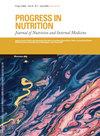颈围能预测心脏代谢的危险因素吗?前瞻性横断面研究
4区 医学
Q4 Agricultural and Biological Sciences
引用次数: 0
摘要
背景和目的:本研究旨在评估颈围(NC)与几个心脏代谢风险参数之间的关系,并将其与一些人体测量变量进行比较。方法:共招募331名女性,年龄20-49岁。收集人体测量(体重、身高、腰围和颈围)和生化参数[血清空腹血糖(FBG)、空腹胰岛素(FBI)、甘油三酯、高密度脂蛋白胆固醇(HDL)、低密度脂蛋白胆甾醇(LDL)和纤维蛋白原]。计算稳态模型评估估计IR(HOMA-IR)。结果:根据世界卫生组织的标准,正常体重、超重、肥胖和病态肥胖的女性比例分别为14.2%、31.7%、44.7%和7.9%。71%的女性NC小于37厘米,而29%的女性NC更高。NC与BMI、WC、FBI、HOMA-IR和纤维蛋白原中度相关。NC与FBG(p=0.031)、TG(p=0.000)和LDL胆固醇(p=0.016)呈正弱相关。NC与HDL胆固醇(p=0.000)呈负弱相关。血浆纤维蛋白原与体重(r=0.222)、BMI(r=0.242)、WC(r=0.187)、TG,而HDL胆固醇与血浆纤维蛋白原水平呈负相关(r=-0.119)。结论:颈围与心血管代谢危险因素之间存在显著关系。NC可以用来预测心脏代谢风险,它很容易实现,是一种有效的人体测量方法。它的使用以及广泛用于确定心脏代谢风险的人体测量,如腰围和臀围、腰臀比和BMI,可以提供临床益处。本文章由计算机程序翻译,如有差异,请以英文原文为准。
Can neck circumference predict cardiometabolic risk factors? A prospective cross-sectional study
Background and aim: This study aims to evaluate the association between neck circumference (NC) and several cardio-metabolic risk parameters, to compare it with some anthropometric variables. Methods: A total of 331 women, aged 20-49 years were recruited. Anthropometric measurements (body weight, height, waist and neck circumferences) and biochemical parameters [serum fasting blood glucose (FBG), fasting blood insulin (FBI), triglycerides, high-density lipoprotein cholesterol (HDL), low-density lipoprotein cholesterol (LDL), and fibrinogen] were collected. Homeostasis model assessment-estimated IR (HOMA-IR) was calculated. Results: According to World Health Organization criteria, percentages of women with normal weight, overweight, obese and morbidly obese were 14.2%, 31.7%, 44.7%, 7.9%, respectively. Seventy-one percent of women had NC less than 37 cm, while that of twenty-nine percent of the women had higher. NC was moderately correlated with BMI, WC, FBI, HOMA-IR, and fibrinogen. A positive weak correlation was found between NC and FBG (p=0.031), TG (p=0.000), and LDL cholesterol (p=0.016). Moreover, a negative weak correlation was found between NC and HDL cholesterol (p= 0.000). A positive relationship between plasma fibrinogen and body weight (r=0.222), BMI (r=0.242), WC (r=0.187), TG (r=0.124), and LDL cholesterol (r=0.118) were detected whereas a negative relationship were found between HDL cholesterol and plasma fibrinogen (r=- 0.119) levels. Conclusion: A significant relation is existent between neck circumference and cardio-metabolic risk factors. NC could be used, it is easy to implement, an effective anthropometric measurement to the prediction of cardio-metabolic risks. Its usage together with anthropometric measurements such as waist and hip circumferences, waist-hip ratio and BMI which are widely used to determine cardio-metabolic risks can provide clinical benefits.
求助全文
通过发布文献求助,成功后即可免费获取论文全文。
去求助
来源期刊

Progress in Nutrition
医学-营养学
CiteScore
1.40
自引率
0.00%
发文量
0
审稿时长
>12 weeks
期刊介绍:
Progress in Nutrition was founded in 1999 as an independent magazine, a multidisciplinary approach, dedicated to issues of nutrition and metabolism.
 求助内容:
求助内容: 应助结果提醒方式:
应助结果提醒方式:


